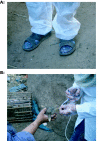Avian influenza vaccination in Egypt: Limitations of the current strategy
- PMID: 20076791
- PMCID: PMC2805840
- DOI: 10.4172/1747-0862.1000035
Avian influenza vaccination in Egypt: Limitations of the current strategy
Abstract
Vaccination of domestic poultry against avian influenza (AI) has been used on a large-scale in South East Asia since 2003 and in Egypt since 2006 to fight H5N1 highly-pathogenic avian influenza (HPAI) epidemics. The decision to use mass vaccination against HPAI in Egypt was taken as an emergency measure based on positive impact of such control measures in Vietnam and the People's Republic of China. However, three years on, the impact on disease control of AI vaccination in Egypt has been very limited. Despite the continuous vaccination of poultry against HPAI, poultry outbreaks and human cases are reported regularly. A recent assessment study highlighted substantial weaknesses in the current immunisation programme and its lack of positive impact on the spread of infection or the maintenance of public health safety. The shortcomings of the vaccination strategy may be attributed in part to a lack of sufficient support in terms of funding and communication, the absence of an efficient monitoring system, and inadequate training of field technicians. The difficulties of blanket vaccinations in semi-commercial farms and household poultry sectors are well known, however, improvements in the industrial sector should be possible though better government controls and greater collaboration with the private sector. AI vaccination should be regarded as just one control tool within a broader disease control program integrating surveillance, outbreak investigation, disease management systems, and the rigorous implementation of bio-security measures. If incorrectly implemented, AI vaccination has a limited impact as a disease control measure. Moreover, without strict bio-security precautions undertaken during its application, farm visits to vaccinate poultry could facilitate the spread of the virus and therefore become a risk factor with important implications on the maintenance of the virus and potential risk for human exposure.
Keywords: Avian influenza; Egypt; disease control; public health risk; vaccination strategy.
Conflict of interest statement
None declared.
Figures

References
-
- Busani L, Toson M, Stegeman A, et al. Vaccination reduced the incidence of outbreaks of low pathogenicity avian influenza in northern Italy. Vaccine. 2009;27:3655–3661. - PubMed
-
- Capua I, Schmitz A, Jestin V, Koch G, Marangon S. Vaccination as a tool to combat introductions of notifiable avian influenza viruses in Europe, 2000 to 2006. Rev Sci Tech. 2009;28:245–259. - PubMed
-
- Domenech J, Dauphin G, Rushton J, et al. Experiences with vaccination in countries endemically infected with highly pathogenic avian influenza: the Food and Agriculture Organization perspective. Rev Sci Tech. 2009;28:293–305. - PubMed
-
- Ellis TM, Sims LD, Wong HK, et al. Use of avian influenza vaccination in Hong Kong. Dev Biol (Basel) 2006;124:133–143. - PubMed
LinkOut - more resources
Full Text Sources
